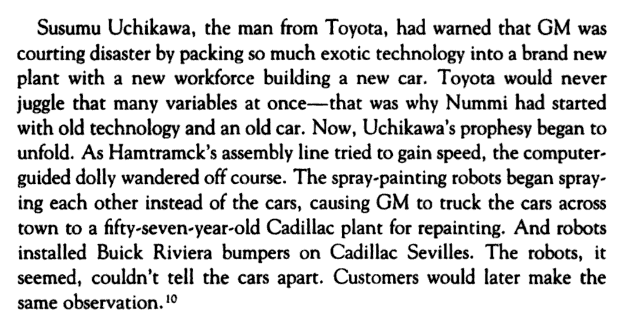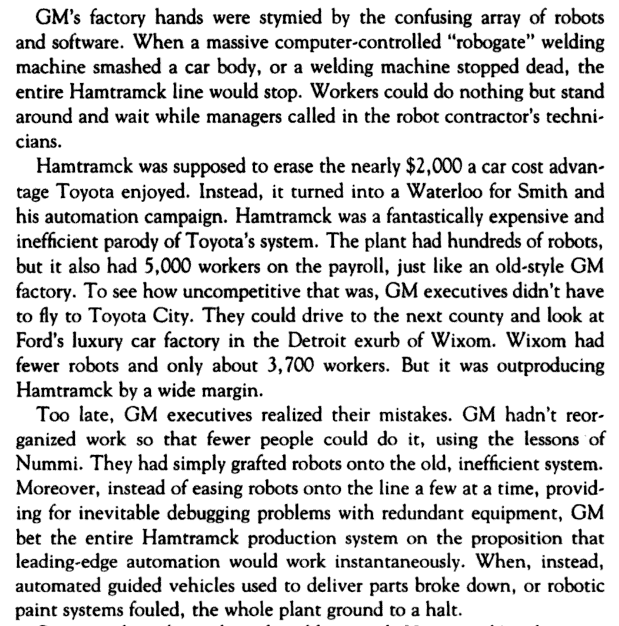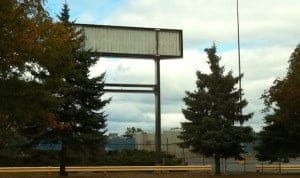Thanks to this post by Bruce Hamilton (aka “Toast Guy” or “Old Lean Dude”), I was reminded of the old General Motors effort, spearheaded by then-CEO Roger Smith (of “Roger & Me” fame), to fully automate car factories. Their concept was the “lights-out factory” that could run without people (other than a security guard).
GM invested $90 BILLION dollars over 10 years in this quixotic (if not foolhardy) quest. The robots often famously painted each other instead of painting cars, as described in the book Comeback:


As Dan Markovitz asked in a comment on Bruce's post, imagine if they had invested earlier in creating a Lean culture, working with their employees instead of trying to replace them? Imagine if they had more quickly learned the lessons from NUMMI? It's also a story that warns of the consequences of not first trying a “small test of change.”
In searching for a reference to the $90B number, I found this column written after Smith's death by Doron Levin, who has covered the auto industry for all of my adult life and then some:
GM's Roger Smith Was A Financial Genius With Faulty Vision For Future
This jumped out at me, in particular:
“Needless to say, robotic car factories remain a fantasy.
Union-management relations, meanwhile, are as dysfunctional as ever. To satisfy his curiosity about competition from Japan, Smith agreed in 1984 to a joint manufacturing venture with Toyota Motor Corp. at a mothballed GM plant in Fremont, Calif [NUMMI].
But the key lessons about Toyota quality that his executives learned weren't what he wanted to hear.
“He thought Toyota possessed some kind of magic,” said Maryann Keller, a former auto industry analyst and author of “Rude Awakening,” a book about the automaker published in 1990.
“The Toyota joint venture taught that GM management was the problem.”
The trick to cost savings wasn't simply getting rid of people. GM had to motivate workers in factories and yes-men in executive suites to take more responsibility and improve output. GM quality and productivity were second-rate.
I tried and failed to find out whether Smith ever read “The Machine that Changed the World…”
I wonder if Smith ever read the book. I doubt he did.
Hear Mark read this post — subscribe to Lean Blog Audio
And think about the parallels from that Levin column to healthcare today… attempts to cut costs (laying off people), poor quality and productivity, leaders not realizing the problem is the management system…
Dr. Deming tried telling GM much earlier that GM management was the problem. That made Dr. Deming pretty unwelcome around GM.
Toyota doesn't have some kind of magic. In healthcare, ThedaCare doesn't have some kind of magic.
They manage differently. ThedaCare had to CHANGE the way they manage. The secret isn't “motivating workers” — the secret is engaging them in improvement.
Others can do this… but it requires humility, dedication, and a willingness to change… not magic.
Too many healthcare executives are trying to cut costs by “getting rid of people.” Everybody needs to work together to improve quality and productivity at the same time. As Deming said, it starts in the boardroom.
What do you think? Please scroll down (or click) to post a comment. Or please share the post with your thoughts on LinkedIn – and follow me or connect with me there.
Did you like this post? Make sure you don't miss a post or podcast — Subscribe to get notified about posts via email daily or weekly.
Check out my latest book, The Mistakes That Make Us: Cultivating a Culture of Learning and Innovation:











Great reflections, Mark. I believe that healthcare is going through the same struggle that the U.S. automotive companies went through. There is a lot of low hanging fruit with the basic lean process tools, but to really achieve excellence requires a change in management methods.
I toured GM’s Saginaw Steering Gear “plant of the future” in about 1988, which was a lights-out factory producing suspension parts – except the lights were on, and production was at a snail’s pace due to some undisclosed problem. Today, the plant is doing well under Chinese ownership as Nexteer”. A good friend of mine in production management at Delco division told me their direction was that labor costs with the UAW would keep increasing, so the only way out was to increase automation to eliminate the labor. GM was certainly in the firm grip of the bean counters.
It’s true that labor costs would always keep increasing… same is true for other automakers, I guess, including Toyota.
Now that I think about it, wages actually have gone down with the tiered wages that the UAW agreed to during the bailout period, etc.
But, the automation strategy would have only worked if the automation actually worked well enough?
I’m not sure whether the story about robots painting robots is urban legend or not. I worked closely with the Detroit-Hamtramck plant in the late 1980’s – there may have been spray getting on other robots, but people imagine robots having a gunfight at OK Corral. We supported the workers on the line. As an engineer, I spent a day installing air conditioning compressors. On the V8 engines, it was easy, installing the refrigerant hoses to the compressor before installing the assembly on the engine. On the v6, there was not room to install the hoses first, so the compressor was installed to the engine, then the hoses were added, with difficulty. I could not keep up with the V6’s. Afterwards, warranty data showed the V6 had 3 times the leaks at the hose than the V8 – a design change was made. There were engineering and manufacturing management there who were followers of Dr. Deming, such as Cadillac Chief Engineer Bob Dorn and GM Group VP Bill Hoglund (who acted on the NBC Whitepaper “If Japan Can, Why Can’t We” and brought Dr. Deming to GM)
“I could not keep up with the V6’s” — that’s clearly a design issue (a Design For Assembly, DFA) problem. But, the traditional old GM culture would have put “making the production quota” ahead of quality and probably would have blamed the workers for not keeping up. Maybe they were nicer to you since you were an engineer?
It was the line workers who cut me slack for being an engineer, and they quickly made up for my falling behind. They really appreciated someone being there and caring.
For me, in 1995, it took a lot of jumping through hoops for me to even be able to work on the engine assembly line for an hour. The union had to approve and the UAW employee had to be right there 1) to make sure I was tightening bolts properly and 2) that I wasn’t “replacing” a worker. I was there to try to better understand the work… and, like you said, people generally appreciated that.
I just finished 1 week tour (4 cities/4 days) visiting with some industry executives and well known lean consultants and advisors including Steven Spears. The focus was on the preparedness of industry and the lean consulting community to address the forthcoming digital transformation (don’t fool yourself–it’s coming). Unfortunately what I learned is that most don’t even know what digital transformation is or looks like and the cheery-picky has already started (I-pads, google glass, etc.) just like it did with lean (5S, kaizen workshops, etc.) when it became the vision of the future. More to the point, it’s also taking the same path as GM and the robots–magical bullets without preparedness
Hey Mark,
This is looking like a poor performance by GM’s Top Management.
I think they could have taken a softer approach into integrating the robots instead of putting the robots to work all at once.
GM’s Top Management didn’t seem like they were ready for such a transition.
Do you think integrating robots is a good idea in general?
Could robots be configured to perfectly achieve the assembly of the car? and with that reduce waste?
thanks,
[…] their 1994 book Comeback, Paul Ingrassia and Joseph White (Author) described the results of Smith’s automation project at GM’s plant in Hamtramck, […]
[…] their 1994 book Comeback, Paul Ingrassia and Joseph White (Author) described the results of Smith’s automation project at GM’s plant in Hamtramck, […]
[…] wonder if Musk was aware of the history of Roger Smith and the robots at GM when he established his manufacturing […]
Musk’s Tesla plant in the old NUMMI plant in Fremont, CA is having a lot of problems with robots. They were going to have an empty factory just like GM’s Roger Smith. Didn’t work so they hired experienced assembly workers to do a lot of the work. Apparently even after 8 or so years the fit and finish isn’t very good on their $40,000-90,000 cars.
The $90 billion dollar lights-out factory failure of the 1985-1995 era of Roger Smith was easily foreseen. They wasted all of that money. GM Could have bought Toyota and Honda for $90 billion dollars. Of course they’d probably destroyed them too. I’m not a GM hater. Our families have owned Buicks, Oldsmobiles, GMC pickups, GMC SUVs, Pontiacs, Chevrolets and even some Cadillacs. The quality is much worse than it was and to make matter much worse they’re very hard to work on. A shadetree mechanic like myself could get them back on the road pretty easily. I put on a starter ($90 dollars new)on a 1990 Buick Riveria in 30 minutes. Not now.